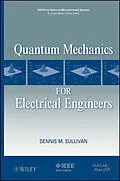The main topic of this book is quantum mechanics, as the title indicates. It specifically targets those topics within quantum mechanics that are needed to understand modern semiconductor theory. It begins with the motivation for quantum mechanics and why classical physics fails when dealing with very small particles and small dimensions. Two key features make this book different from others on quantum mechanics, even those usually intended for engineers: First, after a brief introduction, much of the development is through Fourier theory, a topic that is at the heart of most electrical engineering theory. In this manner, the explanation of the quantum mechanics is rooted in the mathematics familiar to every electrical engineer. Secondly, beginning with the first chapter, simple computer programs in MATLAB are used to illustrate the principles. The programs can easily be copied and used by the reader to do the exercises at the end of the chapters or to just become more familiar with the material. Many of the figures in this book have a title across the top. This title is the name of the MATLAB program that was used to generate that figure. These programs are available to the reader. Appendix D lists all the programs, and they are also downloadable at href="http://booksupport.wiley.com/">http://booksupport.wiley.com
Autorentext
DENNIS M. SULLIVAN is Professor of Electrical and Computer Engineering at the University of Idaho as well as an award-winning author and researcher. In 1997, Dr. Sullivan's paper "Z Transform Theory and FDTD Method" won the IEEE Antennas and Propagation Society's R. P. W. King Award for the Best Paper by a Young Investigator. He is the author of Electromagnetic Simulation Using the FDTD Method.
Inhalt
Preface xiii
Acknowledgments xv
About the Author xvii
1. Introduction 1
1.1 Why Quantum Mechanics? 1
1.1.1 Photoelectric Effect 1
1.1.2 WaveParticle Duality 2
1.1.3 Energy Equations 3
1.1.4 The Schrödinger Equation 5
1.2 Simulation of the One-Dimensional Time-Dependent Schrödinger Equation 7
1.2.1 Propagation of a Particle in Free Space 8
1.2.2 Propagation of a Particle Interacting with a Potential 11
1.3 Physical Parameters: The Observables 14
1.4 The Potential V(x) 17
1.4.1 The Conduction Band of a Semiconductor 17
1.4.2 A Particle in an Electric Field 17
1.5 Propagating through Potential Barriers 20
1.6 Summary 23
Exercises 24
References 25
2. Stationary States 27
2.1 The Infinite Well 28
2.1.1 Eigenstates and Eigenenergies 30
2.1.2 Quantization 33
2.2 Eigenfunction Decomposition 34
2.3 Periodic Boundary Conditions 38
2.4 Eigenfunctions for Arbitrarily Shaped Potentials 39
2.5 Coupled Wells 41
2.6 Bra-ket Notation 44
2.7 Summary 47
Exercises 47
References 49
3. Fourier Theory in Quantum Mechanics 51
3.1 The Fourier Transform 51
3.2 Fourier Analysis and Available States 55
3.3 Uncertainty 59
3.4 Transmission via FFT 62
3.5 Summary 66
Exercises 67
References 69
4. Matrix Algebra in Quantum Mechanics 71
4.1 Vector and Matrix Representation 71
4.1.1 State Variables as Vectors 71
4.1.2 Operators as Matrices 73
4.2 Matrix Representation of the Hamiltonian 76
4.2.1 Finding the Eigenvalues and Eigenvectors of a Matrix 77
4.2.2 A Well with Periodic Boundary Conditions 77
4.2.3 The Harmonic Oscillator 80
4.3 The Eigenspace Representation 81
4.4 Formalism 83
4.4.1 Hermitian Operators 83
4.4.2 Function Spaces 84
Appendix: Review of Matrix Algebra 85
Exercises 88
References 90
5. A Brief Introduction to Statistical Mechanics 91
5.1 Density of States 91
5.1.1 One-Dimensional Density of States 92
5.1.2 Two-Dimensional Density of States 94
5.1.3 Three-Dimensional Density of States 96
5.1.4 The Density of States in the Conduction Band of a Semiconductor 97
5.2 Probability Distributions 98
5.2.1 Fermions versus Classical Particles 98
5.2.2 Probability Distributions as a Function of Energy 99
5.2.3 Distribution of Fermion Balls 101
5.2.4 Particles in the One-Dimensional Infinite Well 105
5.2.5 Boltzmann Approximation 106
5.3 The Equilibrium Distribution of Electrons and Holes 107
5.4 The Electron Density and the Density Matrix 110
5.4.1 The Density Matrix 111
Exercises 113
References 114
6. Bands and Subbands 115
6.1 Bands in Semiconductors 115
6.2 The Effective Mass 118
6.3 Modes (Subbands) in Quantum Structures 123
Exercises 128
References 129
7. The Schrödinger Equation for Spin-1/2 Fermions 131
7.1 Spin in Fermions 131
7.1.1 Spinors in Three Dimensions 132
7.1.2 The Pauli Spin Matrices 135
7.1.3 Simulation of Spin 136
7.2 An Electron in a Magnetic Field 142
7.3 A Charged Particle Moving in Combined E and B Fields 146
7.4 The HartreeFock Approximation 148
7.4.1 The Hartree Term 148
7.4.2 The Fock Term 153
Exercises 155
References 157
8. The Green's Function Formulation 159
8.1 Introducti...
